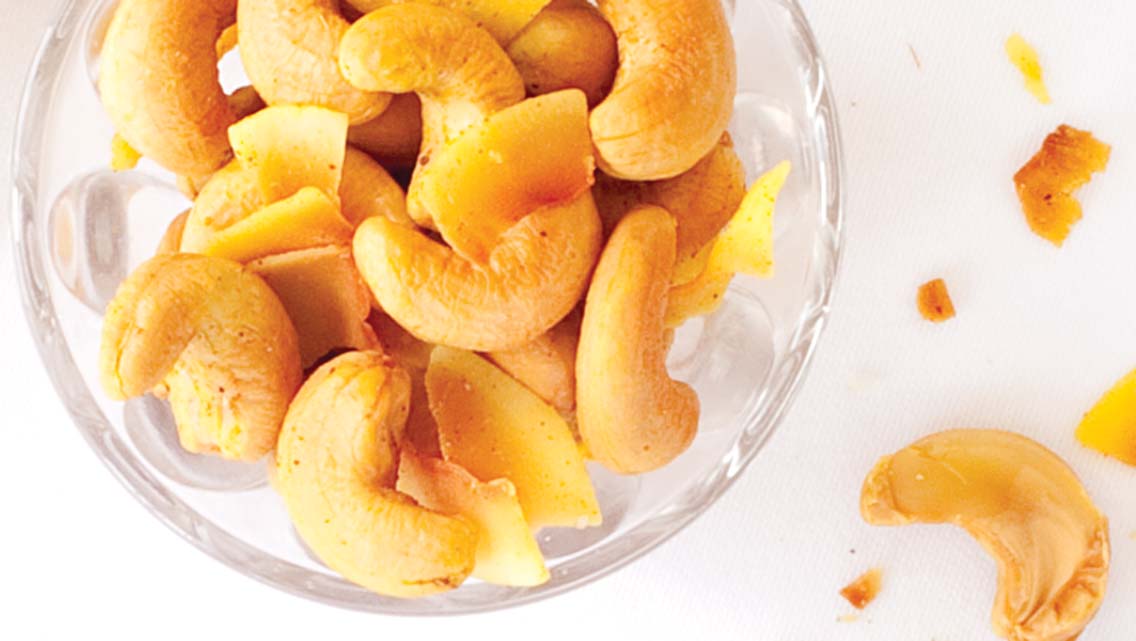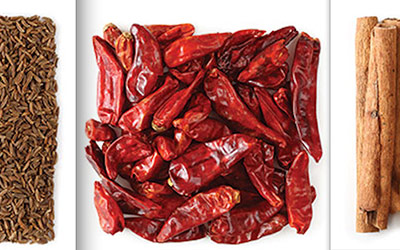The next time you grab some cumin from your cupboard to add to your simmering curry, pause to notice how aromatic and potent it is. It’s likely traveled a long distance — passing through multiple hands over more time than you might expect — to bring its earthy, slightly smoky flavor to your meal.
Spices are the dried seeds, fruit, roots, or bark of plants — most any part but the leaves, which are considered herbs. They’ve been revered for millennia, even used in some ancient cultures as a form of currency. Because of their health benefits, certain spices have been prized in Ayurvedic medicine for 3,000 years; Hippocrates employed them in his medical treatments as well.
In medieval times, spices helped preserve meat and mask the taste if it had gone bad. And of course, they’ve long been treasured for the robust flavors and rich aromas they add in cooking.
Throughout history, empires have waged wars and colonized nations in an effort to dominate the spice trade — notably in India, which still produces the majority of the world’s spices. But according to Sana Javeri Kadri, founder and CEO of spice purveyor Diaspora Co., not much has changed for farmers since India’s days as a British colony: Small-scale spice farmers are still caught in a system that doesn’t serve them.
The Long Spice Route
When spice farmers sell their wares to traders for exporting, they’re at the mercy of the price set by the commodity market. “This commodity trading system was set up by colonialism and never really shifted,” Kadri says. “Indian traders just took the place of the colonizers.”
Spice traders export their goods internationally via a convoluted web of intermediaries. Spices must first be processed: graded, cleaned, dried, ground, and packaged. Then they go to exporters, further brokers, and more processing, shipping, and distributing — all before they get to your local store.
There can be as many as 10 or even 20 steps before a spice gets to your cabinet. One of the downsides of this long supply chain is that each step adds cost to the final product — so the consumer pays more, and the farmers still make less.
It also means that spices can take a really long time to get to your kitchen.
“Conventional spices can go to the consumer and be up to seven years old sometimes,” says Kadri. “Because they just sat in warehouses all across the supply chain until everybody got a better price. Somebody held it for one year because they wanted a better price, and somebody else held it for one year because they wanted a better price. There’s no urgency to get it to the customer.”
Vibrancy of flavor and nutritional value can suffer during the long transit. Turmeric, for instance, is known as a powerful anti-inflammatory, largely because of the high amount of curcumin it contains.
But, says Kadri, “curcumin is an active compound, so the older it gets, the lower the curcumin content drops.” After that yearslong trip to your grocery store, that turmeric can essentially be just yellow dust.
6 Tips for Sourcing Good Spices
If you want to buy fresh seasonings grown by farmers who are treated fairly, keep these suggestions in mind.
1. Prioritize Fair Trade
The first thing to look for on your spice jar is a fair-trade certification. One of the most common in the United States is from Fair Trade USA, an organization that seeks to improve the lives of farmers and farm workers.
Because spices are farmed in dozens of countries around the world, the needs of the farmers or farm workers can vary greatly, according to John Goad, a producer services manager for Fair Trade USA. Fair-trade workers on industrial-scale farms, for example, must be paid the local minimum wage and have other protections like guaranteed breaks and freedom from discrimination.
Smaller farms might get more benefit from a Fair Trade Premium: money earmarked to directly address community needs, such as education, clean water, and gender equality. Often the premium paid to small spice farmers goes back into their product, Goad says, so the Fair Trade USA seal can be an indicator of a better-quality spice, too.
Some people argue that fair-trade certification doesn’t go far enough, and that the costs for the farmers to get certified are too onerous. But given the lack of information on mainstream brands’ labels, it’s better than nothing.
2. Seek Out Organic
If you’re concerned about the use of agrochemicals and want to support sustainable farming practices, look for the USDA organic label on your spice jars. To be certified organic by the USDA, a crop has to come from soil that has had no fertilizers, insecticides, or herbicides for at least three years and must not be grown using GMOs (genetically modified organisms).
3. Buy in Bulk
Bulk bins are commonplace in many health-food stores, and they’re increasingly on offer in bigger markets. When you buy in bulk, you control the amount you buy — and if you get only as much as you need to use in a month or so, you’ll ensure that your spices are as fresh as possible.
You can also get a smaller amount of an unfamiliar spice to experiment with. That way, you spend less and what you don’t use doesn’t sit on your shelf for ages and deteriorate.
4. Grind Them Yourself
Whole spices like peppercorns, cumin seeds, and allspice berries have a longer shelf life than the ground stuff. Because grinding spices releases their aromatic oils, buying whole spices and grinding them yourself will get you the freshest flavor.
Consider investing in a mortar and pestle or a spice grinder. Don’t use your coffee grinder for spices, as those aromatic oils can affect the taste of your java.
5. Shop Online
Several online spice companies — like the ones listed below — buy directly from farmers, which means the farmers make a better profit and the spices are fresher: They can get to you in as little as three weeks from harvest.
- Diaspora Co. buys 30 single-origin spices from 150 farms across India and Sri Lanka. While the spices are neither fair-trade nor organic certified, Diaspora pays the farmers six times the commodity rate, and the farmers use the same organic techniques they always have.
- Burlap & Barrel buys from small farms, paying them two to 10 times market rate. The company stresses sustainability in its sourcing, and the website offers details about each spice’s origin.
- Curio Spice Co. sources from small, sustainable farms all over the world and pays them well above market prices. A women-owned company, Curio prioritizes women-owned farms and organic, fair-trade ingredients.
- Mala Market is owned by a mother-and-daughter team that specializes in Sichuan ingredients and buys directly from farmers and manufacturers there.
- Cinnamon Tree Organics buys organic, single-origin spices from growers in Sri Lanka.
6. Replace as Needed
Once you bring your spices home, how long do they keep? Recommendations vary dramatically. Frontier Co-op spices have a best-by date on every bottle, but in general it advises one to two years for ground spices and two to three years for whole.
McCormick says its ground spices should be used within two to three years; whole spices within three to four years. Diaspora’s spices also each have a best-by date, which is generally 18 to 20 months from harvesting or milling. Many websites recommend six months.
If you’re unsure about spices on your shelf, give them a sniff. Are they aromatic? Is the color still vivid? How long have they been there? It may be time to toss them and start fresh.





This Post Has 0 Comments